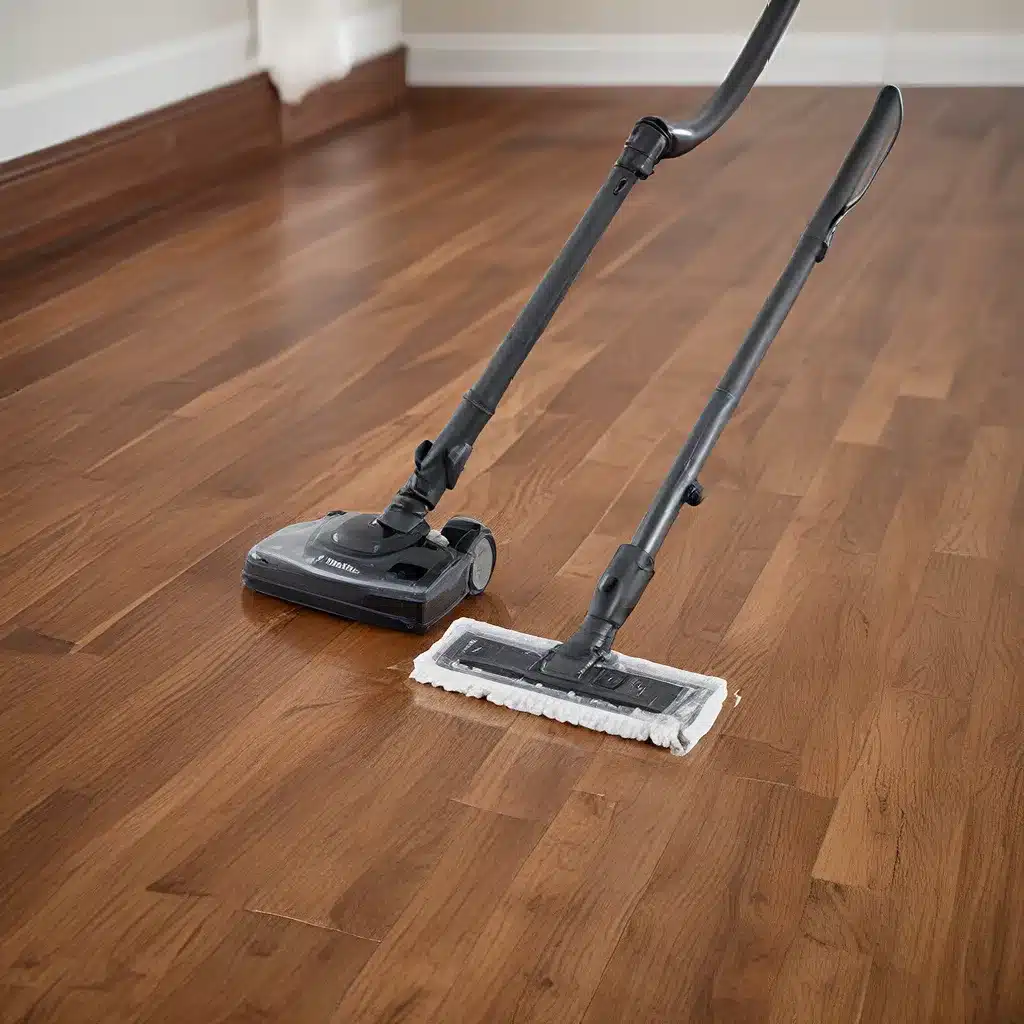As a self-proclaimed cleaning enthusiast, I’ve tried my fair share of floor cleaning methods – from good old-fashioned mops to the latest high-tech gadgets. But when it comes to hardwood floors, the decision on whether to use a steam cleaner isn’t as straightforward as it may seem.
Recently, I found myself in a conundrum after my mom raved about the wonders of her Bissell PowerFresh Steam Mop. She claimed it had transformed her hardwood floors, leaving them sparkling clean with minimal effort. Naturally, I had to give it a try.
The Allure of Steam Cleaning
I’ll admit, the idea of a deep, sanitizing clean without harsh chemicals was incredibly appealing. The thought of simply gliding a steam mop across my floors and watching the grime disappear had me giddy with excitement. After all, who doesn’t love the idea of a quick and effortless cleaning routine?
But as I dove deeper into researching steam cleaners for hardwood floors, I found myself faced with a barrage of conflicting information. Blog posts and forums were rife with warnings about the potential dangers of using steam on wood surfaces.
Apparently, the combination of high heat and moisture from steam cleaners can wreak havoc on hardwood floors, leading to warping, discoloration, and even voiding the manufacturer’s warranty. Suddenly, my excitement turned to apprehension – was I about to commit a cardinal sin against my beautiful 100-year-old hardwood floors?
Separating Fact from Fiction
Determined to get to the bottom of this conundrum, I embarked on a quest to separate fact from fiction. I scoured the internet, read countless reviews, and even reached out to flooring experts, all in the name of uncovering the truth about steam cleaning hardwood floors.
As it turns out, the answer isn’t a simple yes or no. It really boils down to the condition and finish of your hardwood floors. Sealed hardwood floors, with a protective coating like polyurethane, are generally more resilient to the effects of steam cleaning. The sealant acts as a barrier, preventing moisture from penetrating the wood and causing damage.
On the other hand, unsealed or untreated hardwood floors are much more vulnerable. Without that protective layer, the steam can easily seep into the wood, leading to warping, swelling, and even the growth of mold and mildew. For these types of floors, steam cleaning is generally not recommended.
Adam Cleaning offers a range of professional hardwood floor cleaning services, so you can trust that your floors are in good hands.
Mastering the Steam Cleaning Technique
Now, for those of us with sealed hardwood floors, the news isn’t all doom and gloom. Steam cleaning can still be a viable option, as long as we approach it with caution and the right technique.
The key is to use the steam mop on the lowest setting and never let it sit in one spot for too long. This helps minimize the amount of moisture and heat that comes into contact with the floor. Additionally, be sure to go over the area with a dry microfiber mop afterwards, to absorb any residual moisture.
It’s also crucial to check with your flooring manufacturer before proceeding with steam cleaning. Some manufacturers may specifically advise against it, or provide guidelines on the proper way to use a steam mop on their floors.
Exploring Safer Alternatives
Of course, if you’re still hesitant about the risks of steam cleaning, there are plenty of other effective and safe ways to clean your hardwood floors. Damp mopping with a mild cleaning solution, for example, is a time-honored method that minimizes moisture exposure.
Natural cleaners, like a mixture of vinegar and water, offer a gentle yet effective way to tackle dirt and grime without harsh chemicals. And microfiber mops are a game-changer, trapping dust and debris without soaking your floors.
Personally, I’ve found that incorporating a combination of these techniques into my cleaning routine has kept my hardwood floors looking their absolute best. But, as with any home improvement project, it’s always wise to do your research and consult with the experts before diving in.
Navigating the Product Landscape
Now, for those of you who are still curious about the world of steam cleaners, let me share a few of my top product recommendations. The Bissell PowerFresh that my mom raves about is a great option for sealed hardwood floors, as long as you use it carefully.
Another fantastic choice is the Murphys Oil Soap, a plant-based cleaner that’s gentle on wood but highly effective. And Bona’s water-based hardwood floor cleaner is a favorite among homeowners for its ability to clean and maintain the floors without dulling the finish.
While these products can be incredibly helpful in keeping your hardwood floors looking their best, it’s important to remember that no cleaning method is one-size-fits-all. Your floors’ unique needs and your cleaning preferences will ultimately determine the right approach.
The Verdict: To Steam or Not to Steam?
So, after all my research and personal experience, what’s the verdict on using steam cleaners on hardwood floors? Well, it’s a bit of a mixed bag.
For sealed hardwood floors, steam cleaning can be a viable option, as long as you use it judiciously and follow the manufacturer’s instructions to a T. But for unsealed or waxed floors, it’s generally best to steer clear and opt for gentler, water-based cleaning methods.
Ultimately, the decision is up to you. But I encourage you to do your due diligence, understand the condition of your floors, and weigh the potential risks and rewards before making the leap into the world of steam cleaning.
And remember, whether you decide to go the steam route or not, the key to keeping your hardwood floors in tip-top shape is to choose the right cleaning method and products that align with their specific needs. With a little bit of care and attention, you can ensure your floors remain a source of pride and joy for many years to come.







